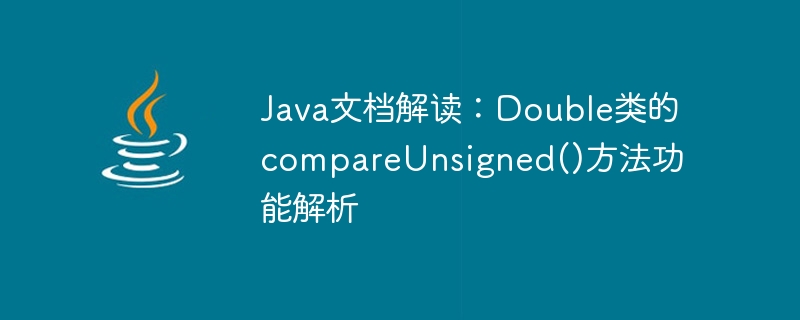

Java is one of the most popular programming languages in the world today. Its rich class library functions provide strong support for programmers to write efficient and maintainable code. Among them, the Double class is one of the basic types in the Java language that represents double-precision 64-bit floating point numbers.
There are many useful methods in the Double class, one of which is often ignored is compareUnsigned(). This article will introduce the function of this method in detail and give specific code examples.
The compareUnsigned() method in the Double class was introduced in the Java 8 version, and its declaration is as follows:
public static int compareUnsigned(double d1, double d2)
The function of this method is to interpret two double-precision floating point numbers as unsigned , and return the comparison results between them. If d1 is equal to d2, it returns 0; if d1 is less than d2, it returns a negative integer; if d1 is greater than d2, it returns a positive integer.
In order to better understand this method, a specific example will be given next. Suppose we need to compare two double precision floating point numbers, and these two numbers are 3.0 and -2.0 respectively. When we directly use the standard comparison method provided by Java, the code is as follows:
double d1 = 3.0; double d2 = -2.0; if (d1 > d2) { System.out.println("d1 is greater than d2"); } else if (d1 < d2){ System.out.println("d1 is less than d2"); } else { System.out.println("d1 is equal to d2"); }
The output result will be "d1 is greater than d2".
However, when we use the compareUnsigned() method, the code needs to be slightly modified:
double d1 = 3.0; double d2 = -2.0; int result = Double.compareUnsigned(Double.doubleToRawLongBits(d1), Double.doubleToRawLongBits(d2)); if (result > 0) { System.out.println("d1 is greater than d2"); } else if (result < 0) { System.out.println("d1 is less than d2"); } else { System.out.println("d1 is equal to d2"); }
The output result is still "d1 is greater than d2". However, if we change the value of d2 to a positive number larger than 0, such as 2.0, the output result will become "d1 is less than d2".
In order to better understand this example, let us explain the implementation principle of the compareUnsigned() method. In Java, a double value is actually represented by 64-bit binary data. This 64-bit binary data is divided into three parts: sign bit (1 bit), exponent bit (11 bits) and mantissa bit (52 bits).
In the compareUnsigned() method, first use the doubleToRawLongBits() method to interpret each double-precision floating-point number as an unsigned integer of type long. Next, compare the size relationship between the two unsigned integers to get the comparison result between them.
It should be noted that the compareUnsigned() method is only suitable for comparing the relationship between positive numbers and negative numbers smaller than 0. If one of the two numbers is greater than or equal to 0, erroneous results may occur. Therefore, you need to be careful when using comparison methods.
In actual programming, we often need to compare double-precision floating point numbers. Using the compareUnsigned() method can avoid problems such as precision errors, thereby improving the accuracy and efficiency of the program. However, there are some details that need to be paid attention to when using this method to ensure that the program runs properly.
In general, the Double class in Java is a widely used basic data type. The compareUnsigned() method provides a new way to compare double-precision floating point numbers, which can avoid inaccuracies caused by problems such as precision errors. At the same time, this method also reminds us that we need to pay attention to some details when comparing double-precision floating point numbers.
The above is the detailed content of Interpretation of Java documentation: Analysis of the compareUnsigned() method function of the Double class. For more information, please follow other related articles on the PHP Chinese website!
